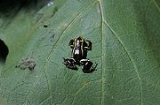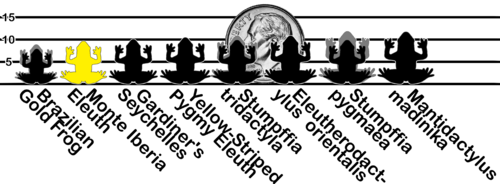
Monte Iberia Eleuth
Encyclopedia
The Monte Iberia Eleuth is the smallest living frog
in the northern hemisphere, ranging between 9.6 to 9.8 mm (0.377952755905512 to 0.385826771653543 in) in length. It is the second-smallest frog (and tetrapod
) in the world, following the Brazilian Gold Frog
. It was first discovered in 1996 on Mount Iberia, from which the animal gets its name, and exists in only two small regions of Cuba
. Much remains unknown about this small creature.
, working with S. Blair Hedges of Pennsylvania State University
in association with the National Science Foundation
's Biotic Surveys and Inventories Program. On a 1996 expedition to Cuchillas de Moa in search of the Ivory-billed Woodpecker
(now believed to be extinct), four iberia specimens were collected after being uncovered under leaf litter and among the root
s of fern
s in a secondary hardwood forest on the western slope of Monte Iberia. The find was published in the journal Copeia
, where the name Eleutherodactylus iberia was introduced.
, but it is generally darker and the lines on its back do not extend as far to the rear. Because of the extreme miniaturization of the species, it possesses fewer teeth than its cousins and a laryngeal apparatus comparable in size to the head of a pin (resulting in a high-pitched call of a series of irregular chirps, comparable to other species of the genus).
Reproductive data is extremely limited. The female specimen which has provided the sole source of data thus far was found beside an egg, suggesting that iberia lays a single egg in each clutch and that the parents are closely involved in raising the young (as is common with animals who birth few offspring a time).

of eastern Cuba at elevations under 600 meters. The first location is on top of the Monte Iberia tableland where the frog was discovered. The second is smaller (less than 100 km² and sparsely-occupied, near Nibujón at sea level. This latter area has suffered great disturbances over the past 40 years from human activities.
E. iberia exists in areas of closed rainforest with poorly-drained soil; it requires a great deal of humidity
for its survival.
Frog
Frogs are amphibians in the order Anura , formerly referred to as Salientia . Most frogs are characterized by a short body, webbed digits , protruding eyes and the absence of a tail...
in the northern hemisphere, ranging between 9.6 to 9.8 mm (0.377952755905512 to 0.385826771653543 in) in length. It is the second-smallest frog (and tetrapod
Tetrapod
Tetrapods are vertebrate animals having four limbs. Amphibians, reptiles, birds and mammals are all tetrapods; even snakes and other limbless reptiles and amphibians are tetrapods by descent. The earliest tetrapods evolved from the lobe-finned fishes in the Devonian...
) in the world, following the Brazilian Gold Frog
Brazilian Gold Frog
The Brazilian gold frog , also known as Izecksohn's toad, is the smallest frog in the Southern Hemisphere. It was previously called Psyllophryne didactyla....
. It was first discovered in 1996 on Mount Iberia, from which the animal gets its name, and exists in only two small regions of Cuba
Cuba
The Republic of Cuba is an island nation in the Caribbean. The nation of Cuba consists of the main island of Cuba, the Isla de la Juventud, and several archipelagos. Havana is the largest city in Cuba and the country's capital. Santiago de Cuba is the second largest city...
. Much remains unknown about this small creature.
Discovery
The diminutive species was first documented by Cuban scientist Alberto R. Estrada of the Institute of Forest Research in HavanaHavana
Havana is the capital city, province, major port, and leading commercial centre of Cuba. The city proper has a population of 2.1 million inhabitants, and it spans a total of — making it the largest city in the Caribbean region, and the most populous...
, working with S. Blair Hedges of Pennsylvania State University
Pennsylvania State University
The Pennsylvania State University, commonly referred to as Penn State or PSU, is a public research university with campuses and facilities throughout the state of Pennsylvania, United States. Founded in 1855, the university has a threefold mission of teaching, research, and public service...
in association with the National Science Foundation
National Science Foundation
The National Science Foundation is a United States government agency that supports fundamental research and education in all the non-medical fields of science and engineering. Its medical counterpart is the National Institutes of Health...
's Biotic Surveys and Inventories Program. On a 1996 expedition to Cuchillas de Moa in search of the Ivory-billed Woodpecker
Cuban Ivory-billed Woodpecker
The Cuban Ivory-billed Woodpecker or Carpintero real is, or was, a Cuban subspecies of the Ivory-billed Woodpecker . Once classified as a separate species, recent research has indicated that C. p...
(now believed to be extinct), four iberia specimens were collected after being uncovered under leaf litter and among the root
Root
In vascular plants, the root is the organ of a plant that typically lies below the surface of the soil. This is not always the case, however, since a root can also be aerial or aerating . Furthermore, a stem normally occurring below ground is not exceptional either...
s of fern
Fern
A fern is any one of a group of about 12,000 species of plants belonging to the botanical group known as Pteridophyta. Unlike mosses, they have xylem and phloem . They have stems, leaves, and roots like other vascular plants...
s in a secondary hardwood forest on the western slope of Monte Iberia. The find was published in the journal Copeia
Copeia
Copeia is a quarterly peer-reviewed scientific journal covering research in ichthyology and herpetology that was named after Edward Drinker Cope, a prominent American researcher in these fields. It is the official journal of the American Society of Ichthyologists and Herpetologists...
, where the name Eleutherodactylus iberia was introduced.
Description
E. iberia is physically similar to E. limbatus and E. orientalisEleutherodactylus orientalis
Eleutherodactylus orientalis is a species of frog in the Leptodactylidae family.It is endemic to Cuba.Its natural habitat is subtropical or tropical moist lowland forests.It is threatened by habitat loss.-Source:...
, but it is generally darker and the lines on its back do not extend as far to the rear. Because of the extreme miniaturization of the species, it possesses fewer teeth than its cousins and a laryngeal apparatus comparable in size to the head of a pin (resulting in a high-pitched call of a series of irregular chirps, comparable to other species of the genus).
Reproductive data is extremely limited. The female specimen which has provided the sole source of data thus far was found beside an egg, suggesting that iberia lays a single egg in each clutch and that the parents are closely involved in raising the young (as is common with animals who birth few offspring a time).

Habitat
Only two isolated populations are known to exist, both in the Holguín ProvinceHolguín Province
Holguín is one of the provinces of Cuba, the third most populous after Ciudad de la Habana and Santiago de Cuba. It lies in the northeast of the country. Its major cities include Holguín , Banes, Antilla, Mayarí, and Moa....
of eastern Cuba at elevations under 600 meters. The first location is on top of the Monte Iberia tableland where the frog was discovered. The second is smaller (less than 100 km² and sparsely-occupied, near Nibujón at sea level. This latter area has suffered great disturbances over the past 40 years from human activities.
E. iberia exists in areas of closed rainforest with poorly-drained soil; it requires a great deal of humidity
Humidity
Humidity is a term for the amount of water vapor in the air, and can refer to any one of several measurements of humidity. Formally, humid air is not "moist air" but a mixture of water vapor and other constituents of air, and humidity is defined in terms of the water content of this mixture,...
for its survival.
Further reading
- AmphibiaWeb: Eleutherodactylus iberia -- features a more detailed physical description
- http://findarticles.com/p/articles/mi_m1200/is_n23_v150/ai_18965496
- Estrada, A. R. and S. B. Hedges (1996). At the lower size limit in tetrapods: a new diminutive frog from Cuba (Leptodactylidae: Eleutherodactylus). Copeia , 1996(4), 853-859.
- Gomez, A.R., and R. Alonso (2000). "Threatened Amphibians of Cuba." Froglog, 2000(37), 5-6.

